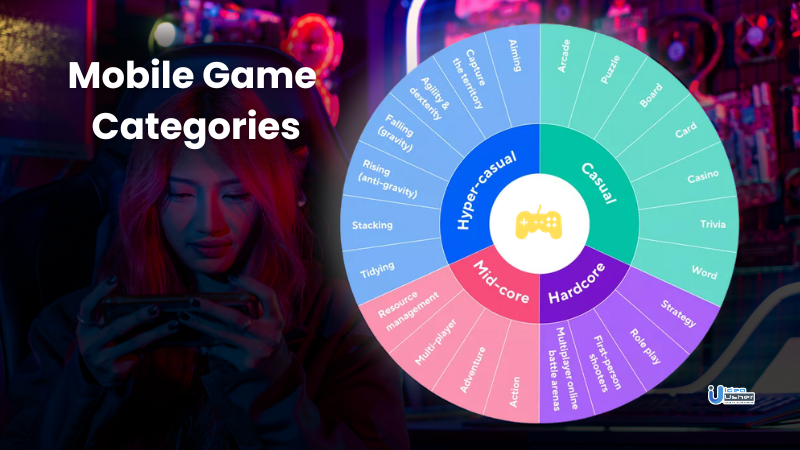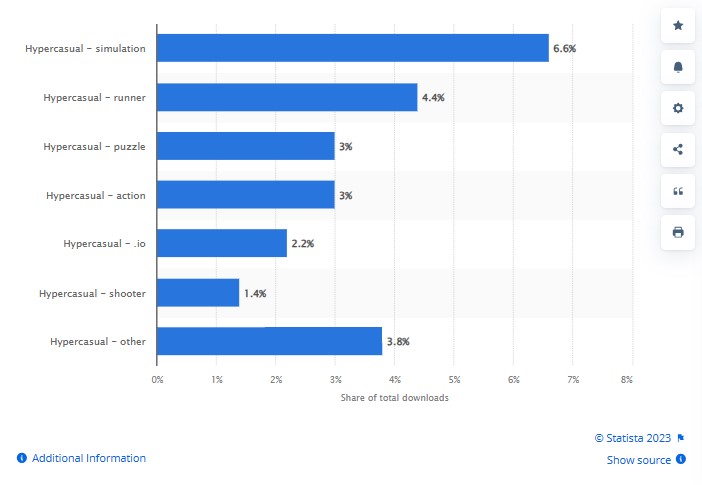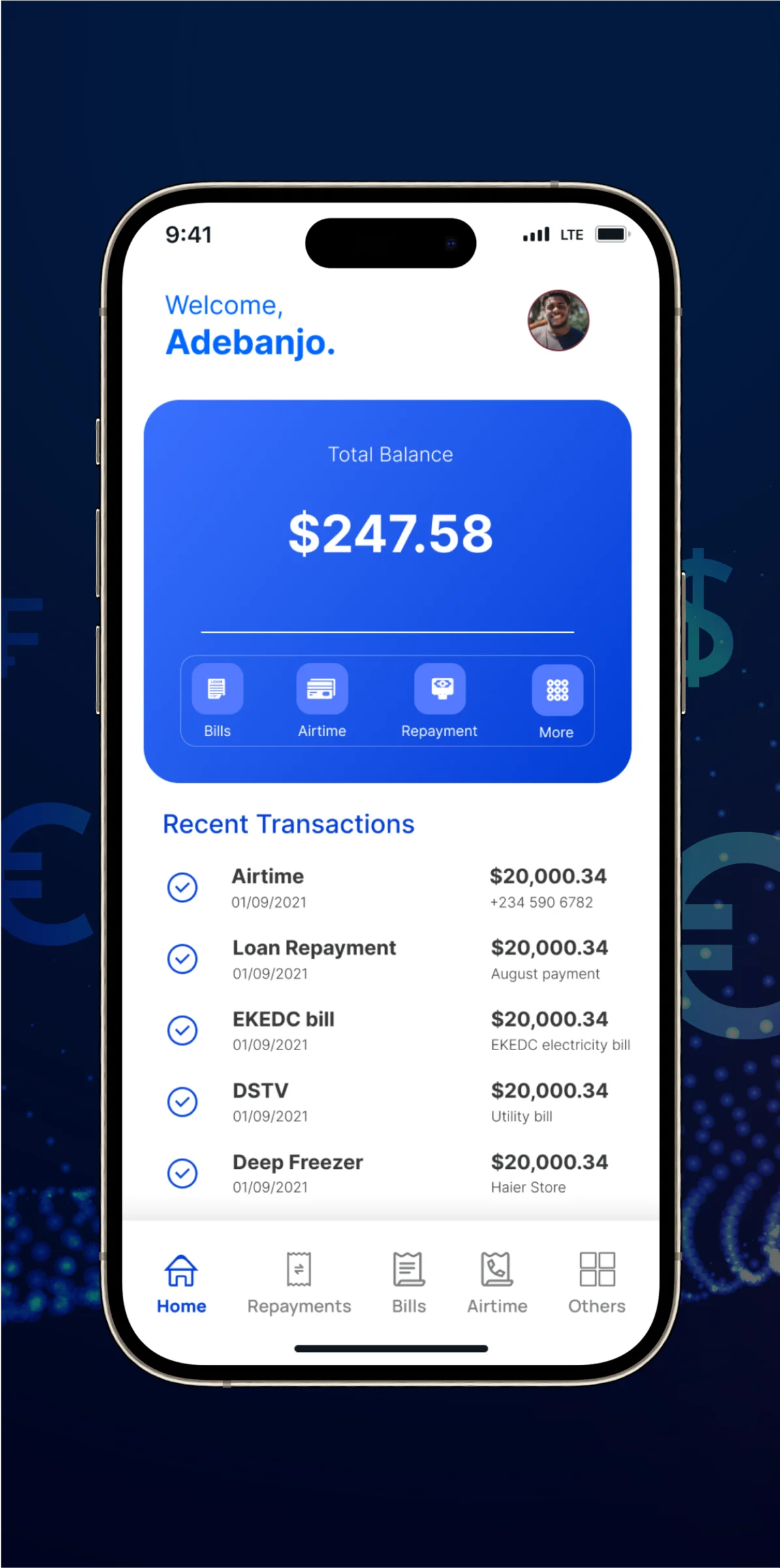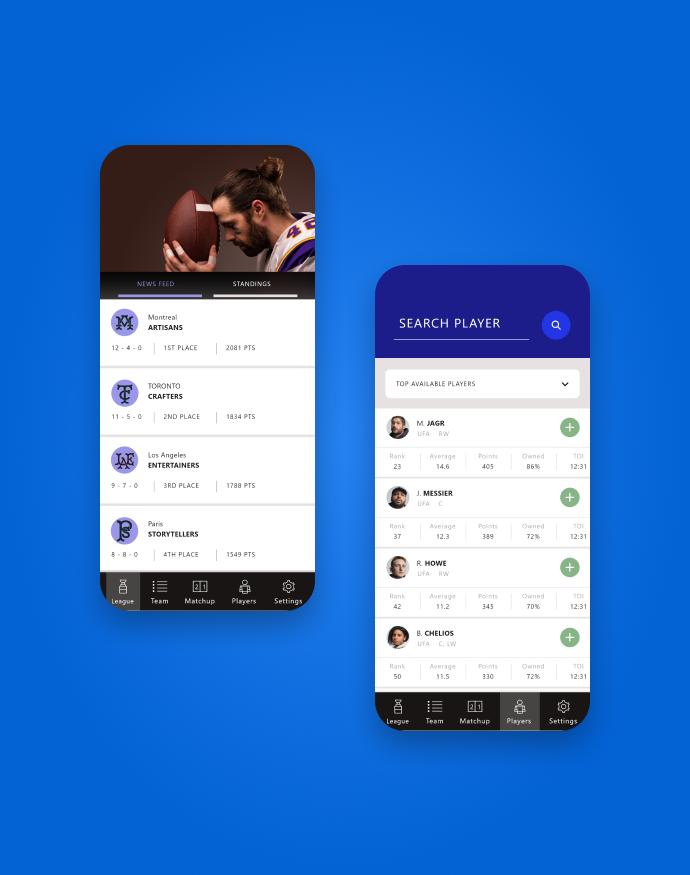- What Is A Hyper Casual Game?
- The Evolution Of Hyper-Casual Games: A Brief History
- Differences: Casual Games, Hyper Casual Games, And Hybrid Casual Games
- Why Are Hyper-Casual Games So Successful?
- What Makes Hyper Casual Game Development Different?
- Who Is a Hyper-Casual Gamer?
- Generating Innovative Hyper-Casual Game Concepts
- Key Features Of A Hyper-Casual Game
- Game Mechanics Of Hyper Casual Games
- How To Develop A Hyper Casual Game?
- Monetization Strategy For Hyper Casual Games
- Top-Grossing Hyper-Casual Games In 2023
- Hyper-Casual Gaming Trends For 2023 And Beyond
- Case Study: The Hyper Casual Gaming Revolution
- Conclusion
- FAQ

Step into the captivating arena of hyper-casual game development! As the fastest-growing genre within the mobile gaming industry, hyper-casual games have taken the world by storm, captivating audiences with their simplicity, accessibility, and engaging gameplay. These games, known for their easy-to-grasp mechanics and minimalist design, have won the hearts of millions of players globally. But what does it take to craft a successful hyper-casual game? Within this comprehensive guide, we embark on an exploration of the unique dimensions of hyper-casual game development, ranging from mastering the genre’s fundamental principles to adhering to a meticulously crafted development blueprint. Consider this guide your indispensable companion, equipping you with the knowledge and insights needed to thrive in the field of hyper casual game development. Let’s plunge into this exciting journey of discovery!
- What Is A Hyper Casual Game?
- The Evolution Of Hyper-Casual Games: A Brief History
- Differences: Casual Games, Hyper Casual Games, And Hybrid Casual Games
- Why Are Hyper-Casual Games So Successful?
- What Makes Hyper Casual Game Development Different?
- Who Is a Hyper-Casual Gamer?
- Generating Innovative Hyper-Casual Game Concepts
- Key Features Of A Hyper-Casual Game
- Game Mechanics Of Hyper Casual Games
- How To Develop A Hyper Casual Game?
- Monetization Strategy For Hyper Casual Games
- Top-Grossing Hyper-Casual Games In 2023
- Hyper-Casual Gaming Trends For 2023 And Beyond
- Case Study: The Hyper Casual Gaming Revolution
- Conclusion
- FAQ
What Is A Hyper Casual Game?
Hyper-casual games have transformed mobile gaming, offering a distinct gaming experience that appeals to a wide audience. These games are characterized by their accessibility, simplicity, and addictive nature. These games are designed to be user-friendly, requiring no prior gaming experience or complex tutorials. Players can pick them up instantly and start enjoying the gameplay without any learning curve. This accessibility makes hyper-casual games inclusive, attracting both casual and hardcore gamers.
Another defining feature is the minimalist user interface. Hyper-casual games strip away unnecessary elements, focusing solely on the gameplay. This design philosophy eliminates distractions and enhances the player’s engagement with the core mechanics. These games often employ 2D designs with vibrant colors and straightforward graphics. This approach not only simplifies the gaming experience but also ensures that players can quickly understand the game’s objectives and controls.
Hyper-casual games are perfect for short bursts of entertainment. Whether you’re waiting in line, commuting, or just have a few minutes to spare, these games offer quick and satisfying gameplay experiences. Their endless loop mechanics keep players coming back for more, striving to beat their previous scores or reach new milestones.
In terms of revenue, Hyper-casual games primarily rely on ads. Players can download and play these games for free, and developers generate income through strategically placed in-game advertisements. This model ensures a large player base and consistent revenue flow. Because of all these bonus factors, these games are a dominant force in the mobile gaming industry, catering to the diverse tastes of gamers worldwide.
The Evolution Of Hyper-Casual Games: A Brief History
Hyper-casual games, the undisputed champions of mobile gaming, have an intriguing history that stretches back to the early days of video gaming. Here’s a deep dive into the journey of this gaming genre:
1. The Pioneers: The Birth Of Video Gaming (1970s)
The roots of hyper-casual gaming stretch back to the early days of video gaming when iconic titles like Pong and Pac-Man set the stage.
Pong and Breakout (1970s): Hyper-casual games owe their roots to classics like Pong (1972) and Breakout (1976). Pong, released by Atari, was a pioneering table tennis-themed game that introduced simple 2D graphics to the world of gaming. It marked the dawn of commercially successful video games.
Pac-Man (1980): Pac-Man, the iconic yellow ball game by Namco, further contributed to the hyper-casual genre. With minimal UI and no tutorials, players were left to figure out the game’s mechanics on their own. Pac-Man’s success led to a wave of sequels, merchandise, and even television series.
Tetris (1984): While not often associated with hyper-casual gaming, Tetris made a significant impact on the genre. Its easy-to-understand gameplay and addictive nature laid the groundwork for future hyper-casual titles.
2. Rise Of The Hyper-Casual Genre (2010s)
The term “hyper-casual games” gained prominence around 2017, signifying a shift in the gaming landscape. These games are characterized by their straightforward mechanics and minimalist design, aimed at making them accessible to a wide audience.
The genre’s rise was propelled by two critical factors: advancements in mobile phone processing power, enabling better graphics and gameplay, and shifting user behavior.
3. Flappy Bird: A Game-Changer (2013)
Often hailed as the pioneering hyper-casual game, Flappy Bird (2013) took the gaming world by storm. Its deceptively simple gameplay mechanics, involving guiding a bird through pipes, struck a chord with players. At its peak, Flappy Bird amassed over 50 million downloads and raked in an astonishing $50,000 daily.
4. Industry Recognition And Investment (2016-2017)
Voodoo and Ketchapp, pivotal players in the hyper-casual game market, made headlines. In 2016, gaming giant Ubisoft acquired Ketchapp, one of the early pioneers in the hyper-casual gaming realm. The genre’s potential attracted substantial investment. Notably, in 2017, Goldman Sachs invested a staggering $200 million in Voodoo, a leading player in the hyper-casual gaming market.
Furthermore, Helix Jump, a Voodoo creation from 2018, exemplified the genre’s appeal. It involved guiding a bouncing ball through circular platforms and achieved viral success.
5. Ad-Driven Revenue Model And Market Dominance
Hyper-casual games embraced an ad-driven revenue model, allowing developers to generate income almost immediately, and these earnings often fuel User Acquisition campaigns to scale the game. The reliance on ads has not only made them financially viable but also accessible to a wide audience.
Furthermore, it is notable that these games quickly climbed the ranks on mobile game stores like the Google Play Store and the App Store (iOS), and they occupied a significant portion of the top-downloaded games.
6. Challenges And Opportunities (Present-Day)
As the market matured, new challenges emerged. Competition intensified, making it vital for developers to innovate and stand out. Hyper-casual games found their niche among users who multitask. In a world where many seek entertainment while juggling various activities, the simplicity of these games became a magnet for players. While other genres explored deeper and more complex gameplay, hyper-casual games remained steadfast in their commitment to easy-to-start, fun-to-play experiences.

Differences: Casual Games, Hyper Casual Games, And Hybrid Casual Games
Casual gaming has diversified into various sub-genres, each catering to distinct player preferences. Let’s dissect the key differences between Casual Games, Hyper-casual Games, and Hybrid Casual Games to gain a deeper understanding of their unique characteristics.
1. Casual Games
Casual games are the gateway to the gaming world for many. They are designed to be easily accessible and embrace simplicity in both gameplay and design.
- Player Base: They target a broad audience, including those who do not regularly engage in gaming, making them inclusive.
- Game Mechanics: These games typically offer straightforward rules and short gameplay sessions and require minimal commitment.
- Monetization: Revenue often comes from in-game purchases and ads, providing options for players to enhance their experience.
2. Hyper Casual Games
Hyper-casual games take simplicity to the extreme. They are the epitome of pick-up-and-play experiences.
- Game Mechanics: Hyper-casual games usually revolve around a single, easy-to-understand mechanic. A single tap or swipe can suffice to engage with the gameplay.
- Minimalism: Their design is minimalist, focusing on the core gameplay without distractions.
- Gameplay Speed: These games often feature rapid gameplay with endless mechanics, driving players to beat their own high scores.
- Monetization: Predominantly reliant on in-game advertisements due to their short lifespans.
3. Hybrid Casual Games
Hybrid casual games strike a balance between simplicity and depth, bridging the gap between the light-heartedness of hyper-casual and the complexity of mid-core games.
- Game Mechanics: While they maintain simplicity at their core, hybrid casuals introduce multiple layers of gameplay mechanics. This offers players more to explore and master.
- Progression: Unlike the endless nature of many hyper-casual games, hybrid casuals often incorporate progression systems. This can manifest as levels, character upgrades, or evolving storylines, providing a sense of accomplishment.
- Monetization: Hybrid casuals expand monetization avenues. In addition to ads, they incorporate in-game purchases, subscriptions, and other revenue streams.
| Feature | Casual games | Hyper casual games | Hybrid casual games |
| Gameplay complexity | Low to medium | Very low | Low to medium |
| Learning curve | Easy | Very easy | Easy |
| Session length | Variable | Short | Short to medium |
| Monetization options | In-app purchases, advertising, subscriptions | Advertising | Advertising, in-app purchases, subscriptions |
Why Are Hyper-Casual Games So Successful?
Hyper-casual games have taken the mobile gaming world by storm, and their meteoric rise is not by chance. A series of strategic elements have propelled these games to the peak of success. Here’s why hyper-casual games have become the reigning champions of the gaming industry:
1. Wide Audience Appeal
Hyper-casual games are designed to be as inclusive as possible. Their simplicity, with just one or two mechanics, ensures that they are universally accessible. This broad appeal spans across age groups, from children to seniors, making them a go-to choice for everyone.
2. Lightweight And Device-Friendly
These games are remarkably lightweight in terms of app size, ensuring compatibility with even older devices that may have limited memory capacity. This accessibility factor extends their reach to a vast array of smartphones and tablets.

3. Effortless Monetization
Monetization in hyper-casual games is seamless and primarily relies on in-game advertisements. Developers can generate revenue through ads without obstructing the gameplay experience. This streamlined monetization strategy contributes significantly to their success.
4. Low-Commitment Entertainment
Hyper-casual games are perfectly tailored for today’s fast-paced lifestyle. They do not demand lengthy playing sessions and are ideal for quick entertainment during daily routines. Whether you’re on a commute, taking a break, or even just need a brief diversion, hyper-casual games are there to fill those moments.
5. Universal Appeal And Accessibility
The hallmark of hyper-casual games is their simplicity, ensuring they appeal to a wide demographic. From seasoned gamers to newcomers, these games offer a seamless entry point into the gaming world.
6. Development Advantages
Developers find hyper-casual games not only fun but also quicker to create than their more complex counterparts. This rapid development pace, combined with the potential for significant return on investment, makes them an attractive choice for game makers.
7. Evolving Demographics And Behaviors
As gaming demographics shift, hyper-casual games are well-positioned to cater to a diverse audience. The changing face of gamers, with older players and a significant female presence, aligns perfectly with the genre’s accessibility and low-commitment nature.
8. Impressive Retention Rates
Hyper-casual games boast the highest retention rates in the gaming landscape. This remarkable stickiness factor ensures that players keep returning for more, providing developers with a dedicated player base.
The success of hyper-casual games is a testament to their ability to adapt to the evolving gaming landscape and capture the hearts of players worldwide. Their wide-reaching appeal, simplicity, and alignment with changing demographics and behaviors make them a formidable force in the gaming industry. As technology continues to advance, hyper-casual games are poised to continue their reign as the go-to choice for quick, enjoyable, and accessible gaming experiences.

The estimated value of the worldwide hyper-casual gaming market is expected to reach approximately USD 15.6 billion in 2021, and it is anticipated to grow to around USD 24.7 billion by 2027. This growth is forecasted to occur at a compound annual growth rate (CAGR) of approximately 7.96% throughout the projected period.

The segmentation of the hyper-casual gaming market encompasses various aspects.
- Firstly, it can be categorized by type, with two primary segments being Android and iOS. Notably, the Android segment is expected to exert dominance over the market throughout the forecast period, signifying its substantial market share and appeal to gamers.
- Secondly, market segmentation also extends to platforms, where the market is classified based on gender into segments of men and women. Within this framework, the men’s segment is anticipated to emerge as the leading force in the market during the research period. This projection suggests a higher engagement and preference for hyper-casual gaming among male users, further highlighting the diversity of the market’s audience and potential avenues for targeted game development and marketing strategies.

North America emerges as the dominant force in the hyper-casual gaming market, holding the largest share. This supremacy is attributed to several factors, notably the region’s status as a technological hub and the presence of a significant number of game developers. The hyper-casual gaming trend has gained substantial traction within the gaming sector of North America.
Moreover, a considerable number of individuals in this region have embraced gaming as a serious profession. Professional gamers, in particular, gravitate towards hyper-casual games due to their simplicity and high level of engagement. Playing these games provides players with a gratifying sense of accomplishment, fostering their continued interest. Collectively, these dynamics have played a pivotal role in propelling the growth and development of the hyper-casual gaming market in North America.

Furthermore, when we compare the total downloads from Q2 2023 to Q1 2023, there’s a noticeable 5% decrease. Over the past three months, the market went from 3.9 billion installs to 3.7 billion. If we look back to Q2 2022, we see a more significant drop of 12% – last year, there were 4.2 billion downloads during the same period. This trend of decline from Q1 to Q2 has been consistent over the years.
Breaking it down regionally, the Tier-1 East market saw the largest decrease, plummeting by 22% compared to the previous quarter’s 15% drop. The Tier-1 West segment also experienced a notable 13% decline, while all other countries combined had a milder 6% fall, similar to Q1 2023.
What Makes Hyper Casual Game Development Different?
Hyper-casual game development is distinguished by its unique characteristics and approach. Understanding these differences is key to navigating this dynamic landscape successfully. Let’s dissect what sets hyper-casual game development apart from other gaming categories:
1. Speed Of Production
Hyper-casual games are the sprinters of the gaming world. They are crafted for rapid production, driven by the need for a constant influx of new titles. Publishers often juggle numerous projects concurrently, necessitating a streamlined development process.
2. Streamlined Processes
To maintain the breakneck pace, hyper-casual studios are masters of efficiency. Unnecessary production tasks are ruthlessly trimmed, and the remaining processes are honed to their leanest form. Every element is optimized for speed without sacrificing quality.
3. Minimal Requirements
Hyper-casual games defy the conventions of traditional game development. They thrive on simplicity, often sidestepping requirements such as localization. Minimalist interfaces and straightforward game mechanics eliminate the need for extensive localization efforts. QA testing, too, is a more straightforward affair, as these games typically revolve around a single core mechanic.
4. Ad-Based Monetization
The lifeblood of hyper-casual games is ad-based monetization. Developers must strategically place mobile advertisements within the gameplay to ensure optimal revenue generation. The effectiveness of these placements directly impacts the game’s success.
5. Unique Business Model
Hyper-casual games follow a distinct business model within the mobile gaming space. Developers must cater to the specific needs and preferences of their target audience. This often means fine-tuning gameplay mechanics for quick, satisfying interactions.
6. Frequent Testing
For the hyper-casual games, testing takes on a whole new dimension. The need for rapid and frequent testing is paramount. Developers aim to iterate hypotheses swiftly, discarding potentially unsuccessful projects in the earliest stages. The emphasis is on agility and adaptability.
Who Is a Hyper-Casual Gamer?
Hyper-casual gamers are individuals who embrace gaming as a casual pastime, fitting it into the gaps of their daily lives. They don’t adhere to a specific gaming genre; instead, their primary criterion is entertainment and engagement. These gamers exhibit a dynamic gaming palate, effortlessly transitioning from a simple puzzle to a complex strategy game based on their mood and circumstances.
Hyper-casual gamers are the quintessential time-killers. Whether it’s during a commute, a visit to the doctor’s office, or while waiting in line, they seize any opportunity for some digital amusement. Their preferences aren’t fixed; they seek light-hearted, enjoyable experiences whenever they have a moment to spare.
According to Facebook’s research, there are seven core motivations driving hyper-casual gaming:
- Stress Relief: Hyper-casual games offer a soothing escape from the pressures of everyday life.
- Time Filler: Gamers turn to these titles to make the most of brief gaps in their schedules.
- Sense of Achievement: Completing in-game challenges provides a sense of accomplishment.
- Immersion in Fantasy: Hyper-casual games transport players to different worlds and characters.
- Uniqueness Appreciation: Gamers are drawn to features and mechanics that set a game apart.
- Nurturing Uniqueness: These games allow players to nurture distinctive aspects of their gaming persona.
- Real-Life Passion: Gamers connect with titles that align with their real-world interests and passions.
Hyper-casual gamers are a versatile and eclectic community of players who value amusement above all else. Their willingness to explore various gaming experiences and motivations makes them a vital force shaping the mobile gaming industry. If you will comprehend and cater to their preferences, you can thrive in this field.
Generating Innovative Hyper-Casual Game Concepts
Hyper-casual games thrive on their simplicity, but that doesn’t mean they lack room for creativity. Despite the genre’s popularity, developers can still craft unique and engaging game ideas by exploring various avenues:
1. Novel Mechanics
Discover mechanics not yet explored in hyper-casual games. Think about how a fresh gameplay mechanic can be integrated into your game. For instance, introduce a mechanic that involves gravity manipulation or time manipulation, offering players a unique challenge.
2. Unconventional Settings
Combine a familiar gameplay mechanic with an unexpected and imaginative setting. For example, create a hyper-casual game where players navigate a spaceship through a candy-filled galaxy, adding a delightful twist to a classic concept.
3. Cross-Genre Fusion
Experiment by merging an unusual mechanic with a well-known sub-genre. Imagine a racing game where players collect items along the track, combining the thrill of racing with the strategy of item collection.
4. Innovative Fusion
Blend two or more popular elements from different games to craft something entirely new. Ensure, however, that the combination remains intuitive and doesn’t overly complicate the gameplay.
5. Elevate Existing Concepts
Take a widely recognized game concept or mechanic and elevate it. Enhance the experience by adding unique features or challenges. For instance, if you have a shooting game, introduce dynamic elements like jumping mechanics or moving targets to make it stand out.
While these suggestions provide a starting point, the most effective way to generate innovative hyper-casual game ideas is through collaborative brainstorming sessions with your team. Pool your creativity, experiment, and refine your concepts until you find the perfect blend of simplicity and novelty. Remember, in the hyper-casual world, a fresh idea can lead to a viral hit.
Key Features Of A Hyper-Casual Game
Here is the comprehensive list of the key features of a hyper-casual game:
1. Radical Simplicity
Hyper-casual games are defined by their extreme simplicity. They feature straightforward gameplay mechanics that are easy to grasp, often requiring just a tap or swipe to play. These games prioritize minimalism in design and user interface, ensuring accessibility for all players.
2. Instant Gameplay Gratification
One hallmark of hyper-casual games is instant gameplay. There are no lengthy intros, complicated menus, or time-consuming tutorials. Players can dive into the action within seconds of launching the game, providing quick and immediate gratification.
3. Total Attention Engagement
Hyper-casual games demand unwavering attention. Once a session begins, there are no breaks until the level is completed. Players must maintain their focus throughout the short gameplay sessions, or they risk losing the game.
4. Infinite Replayability
Many hyper-casual games offer infinite replayability. This is achieved through procedurally generated levels that ensure each playthrough is unique. Players can keep enjoying these games without ever reaching an endpoint, making them perfect for quick gaming sessions.
5. Lightweight And Accessible
Hyper-casual games are lightweight in terms of storage space, making them accessible to a wide range of devices. Their minimalistic approach to graphics and design ensures compatibility with older smartphones as well.
6. Minimal Or No In-App Purchases
Monetization in hyper-casual games predominantly relies on advertisements rather than in-app purchases. This approach promotes fairness and inclusivity, allowing players to enjoy the full gaming experience without spending money.
7. Minimum Mechanics, Maximum Engagement
Despite their simplicity, hyper-casual games excel in providing engaging experiences. They typically revolve around a limited number of mechanics, ensuring that players can jump right in without the need for extensive tutorials.
8. Addictive Gameplay
Hyper-casual games master the art of addictive gameplay. Their simplicity and quick play sessions make them conducive to repeated play as players strive to improve their scores and beat their own records.
9. Short And Sweet Sessions
The average duration of a hyper-casual game session typically ranges from 3 to 6 minutes. This short yet captivating gameplay format perfectly aligns with the fast-paced, on-the-go lifestyle of today’s gamers.
10. Bright And Engaging Visuals
Visual appeal plays a significant role in hyper-casual games. They often feature bright and colorful graphics that are visually stimulating and attention-grabbing, adding to the overall enjoyment of the game.
11. Simple Game Structure
Hyper-casual games follow a simple game structure. They lack intricate modes, level selections, and plot inserts. The gameplay starts immediately upon launching the game, keeping players engaged from the get-go. Even tutorials are kept concise, allowing players to start within 5 seconds of launching the game.
12. Uninterrupted Gameplay
These games maintain an uninterrupted flow. Once the game starts, there are no breaks until the level is completed, and players must remain focused to avoid losing.
13. Repeatability
Hyper-casual games focus on a single goal throughout the gameplay, introducing increasing difficulty levels or new obstacles to keep the experience interesting.
14. Moderate Component Usage
Every aspect of the game, including audio, graphics, and controls, is used sparingly to ensure that players remain fully immersed during gameplay.
15. Simple Monetization Model
Hyper-casual games primarily generate revenue through advertisements, including banner ads, video ads, and reward ads. This model allows for a wider player base to enjoy the game.
Game Mechanics Of Hyper Casual Games
Hyper-casual games typically involve simple, easy-to-understand mechanics that anyone can pick up in seconds. Here are some common game mechanics used in hyper-casual games:
1. Timing Mechanics
Timing games are all about precision. These games challenge players to tap the screen at the perfect moment. Whether it’s hitting a moving target, jumping over obstacles, or slicing through objects, timing mechanics demand split-second decision-making and coordination.
2. Puzzle Mechanics
Hyper-casual games with puzzle mechanics engage players in logical thinking. These puzzles could involve moving objects strategically, solving math-based challenges, or unraveling mysteries. The appeal lies in the simplicity of the puzzle and the satisfaction of cracking it.
3. Merging Mechanics
Merging mechanics revolve around combining similar items to create something new or to score points. Players often match and merge items to reach higher levels or achieve specific objectives. It’s a mechanic that offers a sense of progression and accomplishment.
4. Stacking Mechanics
Stacking games challenge players to balance and stack objects to a certain height or create stable structures. These games often require precise stacking to avoid collapse and progress further, making them both fun and challenging.
5. Swerving Mechanics
Swerving games put players in control of a character or object that they navigate by swiping left or right on the screen. The goal is to dodge obstacles, collect items, or follow a winding path. The simplicity of swiping makes these games accessible to all.
6. Resizing Mechanics
Resizing mechanics involves adjusting the size of objects or elements within the game. This mechanic can be applied creatively across various game themes, offering unique gameplay experiences. It often adds an element of strategy to the gameplay.
7. Turning Mechanics
Turning games require players to make left and right turns, often in a 3D environment. These games can become increasingly complex as players navigate intricate mazes or race through twisting tracks. The challenge lies in precise steering.
8. Rising / Falling Mechanics
Games featuring rising or falling mechanics leverage gravity as a core element. Players may control characters or objects ascending or descending through obstacles. These mechanics can create a thrilling sense of speed and urgency.
9. Aiming Mechanics
Aiming games grant players control over targeting, whether it’s shooting projectiles, protecting against incoming threats, or aiming machines. Precision and accuracy are key to mastering these mechanics.
10. Drawing Mechanics
Drawing mechanics task players with creating shapes, paths, or artistic creations. Whether it’s drawing paths for characters to follow or sketching solutions to puzzles, this mechanic encourages player creativity.
11. Joystick Mechanics
Joystick mechanics introduce virtual joysticks on the screen for character or object control. Players manipulate the joystick to navigate the game world. It’s a versatile mechanic that suits various gameplay styles.
Hyper-casual games thrive on these mechanics because of their simplicity and accessibility. By understanding and strategically implementing these mechanics, game developers can create captivating experiences that resonate with a wide audience of casual gamers.
How To Develop A Hyper Casual Game?
1. Choose The Right Game Engine
Choosing the right game engine is your first crucial decision. Unity, Unreal Engine, Buildbox, and GameMaker Studio are all excellent options. Many of these engines provide hyper-casual game tutorial resources and templates to jumpstart your development process.
Here are the top 5 game engines commonly employed in the creation of Hyper-Casual games:
1.1. Unity 3D
Unity 3D stands as a paramount game development framework renowned for its unparalleled functionality and features. Launched by Unity Technologies, this cross-platform tool offers an all-encompassing solution for mobile game development. It has gained fame due to its distinctive attributes, accommodating pricing structure, and robust capabilities.
1.2. Unreal Engine
The Unreal Engine is a powerhouse among game development engines and has been the driving force behind numerous top-tier games. Its prowess lies in crafting seamless 3D gaming experiences. The engine’s toolkit and functionalities render it an exceptional choice for games that demand superior graphical performance.
1.3. Buildbox
Developing games with Buildbox is remarkably straightforward and expeditious. The process involves selecting images, importing them, assigning roles, and voilà – your game is ready. Buildbox eliminates the need for coding, making it a favored choice among many developers. Furthermore, it boasts an extensive library comprising approximately 20,000 assets, encompassing sound effects and animations.
1.4. GameMaker Studio 2
GameMaker Studio 2 entered the mobile game development arena with the mission of dismantling the entry barriers for individuals without a programming background. Game development using GameMaker Studio 2 essentially boils down to drag-and-drop functionality. This high-end 2D/3D development engine is exceptionally user-friendly, catering to novice developers.
1.5. Cocos 2D-x
Cocos 2D-x serves as a versatile cross-platform 2D/3D game development engine. Its ownership by Facebook ensures comprehensive accessibility to all aspects of the engine. Additionally, Cocos 2D-x facilitates seamless integration with third-party libraries, enabling developers to enhance the engine’s functionality and features effortlessly.
2. Acquire Game Assets
Unlike traditional mobile games, hyper-casual games often don’t require original art content. You can purchase pre-made art assets from marketplaces like the Unity Asset Store, Kenney.nl, or Itch.io and make slight modifications to fit your game’s needs. Some engines even come with pre-built assets, saving you both time and money. As your team grows, you can consider hiring an artist to create original content while still maximizing asset reuse to keep production efficient.
3. Prioritize Gameplay
In hyper-casual gaming, gameplay takes precedence over themes or stories. Start by selecting an engaging game mechanic and build the game around it. Hyper-casual players prioritize simple yet addictive gameplay, making it essential to focus on mechanics that players can grasp intuitively. While themes can add depth, differentiation through gameplay mechanics is key.
4. Develop A Prototype
With your core mechanic and assets in place, create a prototype for testing and optimization. Concentrate on short gameplay loops that players can complete in 30 seconds to a minute. The goal is to keep the experience simple and engaging, ensuring players understand the game without needing a separate tutorial.
5. Prioritize Visuals
In hyper-casual game development, simplicity is supreme, not just in gameplay but in visuals as well. However, simplicity doesn’t imply a lack of aesthetics; rather, it demands a different kind of beauty. The art in your game must be striking despite its simplicity to grab players’ attention in the competitive gaming industry.
During the initial design phase, collaborate with your team to define the visual style that complements your game’s concept. Graphic designers will then provide visual concepts for your approval before diving into development. These harmonious yet uncomplicated visuals are instrumental in attracting and retaining players.
6. Implement Effective Ad Placements
Monetization is vital for hyper-casual games. Implement in-app ads strategically, with full-screen interstitials between gameplay loops being a popular choice. Consider integrating opt-in ads like offerwalls to reward players with in-game bonuses for watching ads. While you can’t control specific ads, you can define where ads appear to maximize revenue.
You can also maximize ad revenue by using ad mediation platforms like AdMob or ironSource. These platforms manage multiple ad networks simultaneously, optimizing your fill rate and eCPM.
Here are some of the most potent monetization approaches tailored for this gaming genre:
6.1. Reward Videos
Reward videos offer players enticing bonuses as a reward for watching advertisements. Importantly, these ads are non-intrusive, allowing players to choose whether they wish to view them. The rewards often include coveted items like skins, extra lives, coins, and power-ups, enhancing the gaming experience.
6.2. Banners
Banner ads strategically occupy the top and bottom sections of the screen. Care must be taken to ensure that their size doesn’t disrupt the user experience. These ads are typically displayed after completing a level or on the menu screen, ensuring minimal disruption during gameplay.
6.3. In-App Purchases
Providing users with the option to make in-app purchases can be a lucrative monetization strategy. Hyper-casual gamers are often willing to invest real money in acquiring new characters, skins, boosters, and power-ups, making this an effective revenue channel.
6.4. Ad Removal
Recognizing that some players prefer an uninterrupted gaming experience, consider offering an ad removal option. Players can make a one-time payment to eliminate all ads, enhancing user satisfaction and providing an instant revenue stream for the developer/publisher.
7. Optimize For Performance
Ensure your game runs smoothly on various devices by optimizing performance. Minimize unnecessary rendering, use efficient asset formats, and follow coding best practices to enhance game performance.
8. Soft Launch And Testing
Before a global launch, conduct a soft launch in cost-effective regions to measure in-game performance with a sample audience. This phase is crucial for refining game systems and optimizing ad placements. It allows you to gather valuable data and feedback to enhance the game’s overall quality. Moreover, experiment with different features and monetization methods using A/B testing. Test ad placements, difficulty levels, and rewards to identify what resonates with your audience best.
Creating a winning hyper-casual game hinges on finding the right balance between simplicity and challenge. The game should start easy and gradually ramp up in difficulty. In the hyper-casual landscape, games can easily become too easy or too hard. To nail the perfect balance, you should extensively test the game using A/B tests. Importantly, you should experiment with different speeds and ensure that everything works together seamlessly to provide players with an enjoyable gaming experience.
9. Craft A Cross-Promotion Strategy
Hyper-casual games may have short lifespans, but they can still contribute to your portfolio’s strength. Implement cross-promotion strategies, such as promoting games from the same studio or partner through in-game ads or App Store links. This tactic encourages players to explore new experiences while boosting your organic traffic over time.
You can explore cross-promotion networks like Chartboost or Tapjoy to promote your game within other apps. This strategy can acquire new users and boost installs without relying solely on ad spend.
10. Utilize Analytics Tools
Integrate analytics tools to gain insights into player behavior. Metrics such as user retention, session length, and ad engagement provide valuable data for game improvement.
Monetization Strategy For Hyper Casual Games
Monetizing hyper-casual games demands a tailored approach distinct from other gaming genres. If you are aiming to excel in this field, employ strategic techniques to maximize revenue while respecting player expectations:
1. In-App Advertisements
Hyper-casual games primarily rely on in-app ads as their revenue lifeline. Players in this genre anticipate ads, making them more receptive to ad placements. Your success hinges on selecting the right ad formats, tracking pertinent metrics, and adhering to industry best practices.
2. Ad Integration From Day One
An often overlooked aspect is incorporating ads right from the game’s inception. Neglecting this until later stages can disrupt the user experience. Integrate ads seamlessly to ensure they complement gameplay without becoming intrusive.
3. Tread Carefully With Interstitial Ads
While interstitial ads can be lucrative, their intrusiveness is well-known. Striking a balance between ad frequency and user engagement is vital. Avoid bombarding players with ads, as this can deter them from returning.
4. Hybrid-Casual Monetization
Consider a hybrid approach by combining in-app ads with in-app purchases (IAPs). Offer players the option to buy in-game currency, power-ups, or exclusive content. This strategy diversifies revenue streams while enhancing player engagement.
5. Player Retention Focus
Hyper-casual gamers are often transient, playing in short bursts. Thus, your monetization strategy should prioritize attracting and retaining a large player base. Encourage repeat playthroughs by offering rewards for watching ads or achieving milestones.
6. Balancing Player Experience
While monetization is essential, it should not compromise the overall gaming experience. Ensure that ads do not disrupt gameplay flow or overwhelm players with frequency.
Top-Grossing Hyper-Casual Games In 2023

In 2022, within the highly downloaded mobile games in the United States, the hyper-casual simulation app subgenre secured a noteworthy 6.6 percent share of gaming app downloads. Hyper-casual runner apps followed closely, ranking second within the hypercasual app spectrum and contributing 4.4 percent to the overall download figures. Remarkably, the comprehensive hypercasual gaming app category collectively comprised nearly one-fourth of all downloads for mobile gaming apps among the top-ranking titles in the United States.
The hyper-casual gaming scene in 2023 has witnessed a surge in popularity, with several standout titles dominating the charts. These games have not only captured the attention of players but have also made a significant impact on the mobile gaming industry. Here are some top-grossing hyper-casual games of the year, each offering a unique gaming experience:
Top 7 Best Hyper-Casual Games In 2023
1. Attack Hole By Homa (73 million downloads in the first half of 2023)
This minimalist masterpiece took the gaming world by storm in early 2023. Attack Hole’s brilliance lies in its simplicity. Players guide a hole through a 2D terrain, devouring objects while evading larger threats. The straightforward concept and addictive gameplay have propelled Attack Hole to the forefront of hyper-casual gaming, making it the standout title of the year.
2. Going Balls By Supersonic (Over 200 million downloads)
Going Balls is an adrenaline-packed adventure that has captivated hyper-casual gamers. With its high-speed challenges and obstacle courses, players must navigate through a series of hurdles. Its fast-paced gameplay and competitive edge have solidified its status as a top-grossing hyper-casual game.
3. Bridge Race By Supersonic (Over 50 million downloads)
Offering a unique blend of strategy and action, Bridge Race has become a sensation in 2023. Players collect blocks of their color and strategically build bridges to traverse platforms. The game’s dynamic gameplay and tactical elements have earned it a spot among the year’s top earners.
4. Race Master 3D By SayGames (Over 100 million downloads)
Race Master 3D is all about perfecting the art of progression. In this thrilling racing game, players must maneuver through challenging tracks, avoid obstacles, and outpace rivals to claim victory. Its engaging mechanics and competitive spirit have made it a top-grossing choice for gamers.
5. Car Games 3D By Zego (Over 50 million downloads)
Variety is the name of the game in Car Games 3D. This title offers a diverse range of mini-games, each featuring cars with unique mechanics and challenges. With its assortment of entertaining experiences, Car Games 3D has garnered a dedicated player base and significant revenue.
6. Magic Tiles 3 By Amanotes (Over 500 million downloads)
Music enthusiasts have found their rhythm in Magic Tiles 3. This rhythm-based game lets players tap on black tiles in sync with the music while avoiding the white ones. Its harmonious blend of music and gameplay has resonated with players, making it a top-grossing hyper-casual game in 2023.
7. Mob Control By Voodoo (Over 50 million downloads)
Mob Control introduces a novel concept where players lead a mob, leveraging strength in numbers to overcome obstacles and challenges. Its unique gameplay mechanics have intrigued gamers, contributing to its success in the hyper-casual gaming landscape.
Hyper-Casual Gaming Trends For 2023 And Beyond
1. Evolution Of Popular Genres
Hyper-casual games are evolving into well-loved genres like runners, IO games, and idle arcades. These genres provide a familiar yet refreshing experience to players, combining simplicity with engagement.
2. Tiktok’s Dominance
TikTok’s influence extends beyond viral videos. Game developers are leveraging TikTok to market their hyper-casual games, effectively using it as a user acquisition channel.
3. Hyper-Casualization Of Casual
Casual games are being distilled into hyper-casual experiences. Complex mechanics are stripped away to create games that are easy to pick up and play, even for those with minimal gaming experience.
4. Depth Within Hyper-Casual
Hyper-casual games are adopting features like metagames and in-game economies, which were once associated with casual titles. This adds layers of engagement, making games more compelling.
5. AR And VR Integration
Expect to see hyper-casual games making use of augmented reality (AR) and virtual reality (VR) technologies. These technologies enhance player immersion and offer unique gameplay experiences.
6. Cloud-Powered Play
Cloud gaming is becoming increasingly important for hyper-casual games, as it allows players to seamlessly access their games across different devices, promoting continuity and convenience.
7. AI And Machine Learning
Developers are integrating AI and machine learning to create personalized gaming experiences. These technologies analyze player behavior and adapt the game’s challenges and content accordingly.
8. Low-Friction Games
The popularity of low-friction games continues to rise. These games are designed for quick and easy engagement, making them appealing to a broad audience.
9. Cross-Platform Dominance
Hyper-casual games are expanding beyond smartphones. Players can now enjoy these games on multiple platforms, including PC, console, and even emerging technologies like smart glasses.
10. Creative Monetization Strategies
Game developers are experimenting with inventive monetization methods. In addition to traditional ads, some are exploring options like microtransactions, cosmetic items, and premium versions to maximize revenue.
11. Scale For Triumph
Success in hyper-casual gaming is increasingly dependent on scale. Games with large user bases and global reach have a competitive edge. Developers are focused on attracting and retaining players.
These trends collectively highlight the dynamic nature of hyper-casual gaming. Staying attuned to these developments will be essential for you to thrive in this ever-evolving industry.
Case Study: The Hyper Casual Gaming Revolution

The hyper-casual gaming market has undergone a staggering transformation, with exponential growth from USD Million to USD Million between 2017 and 2022. The impressive CAGR suggests this market will soar to USD Million by 2029, marking a remarkable journey in the gaming industry. This case study explores the dynamics of the hyper-casual gaming market, highlighting key aspects that have fueled its unprecedented rise.
a. Market Overview
The hyper-casual gaming market is characterized by its wide reach across both Android and iOS platforms. It encompasses diverse game types, including Cloud Gaming, Augmented Reality Gaming, Cross-Platform Play, Blockchain-Based Games, and Casual Games. Regional analysis spans North America, Europe, Asia-Pacific, South America, the Middle East, and Africa.
b. Global Presence
In the hyper-casual gaming arena, industry leaders have emerged with a global presence. These include Tencent Holdings Limited, Zynga, Inc., Kabam Games, Inc., Electronic Arts Inc., GungHo Online Entertainment Inc. (SoftBank Group), NetEase Inc., Rovio Entertainment Corporation, Activision Blizzard Inc., Nintendo Co., Ltd., and Games Inc. (Take-Two Interactive).
c. Hyper Casual Gaming Market Insights
The hyper-casual gaming market’s unprecedented growth is primarily fueled by the surging demand for specific applications worldwide. Android and iOS platforms serve as the primary battlegrounds for this gaming revolution, attracting a massive user base seeking low-commitment, engaging experiences.
d. Product Types
In 2023, certain product types dominated the hyper-casual gaming market. These include Cloud Gaming, Augmented Reality Gaming, Cross-Platform Play, Blockchain-Based Game, and Casual Games. These categories held the largest market share, exemplifying the diversity within the hyper-casual gaming landscape.
e. Market Drivers
The hyper-casual gaming market’s growth is underpinned by the burgeoning demand for specific applications, particularly on Android and iOS platforms. The simplicity and accessibility of these games have broadened their appeal to a global audience.
These games represent a paradigm shift in game development. It stands in stark contrast to the traditional approach of meticulous refinement, opting for volume-driven development. These games are crafted with cost-efficiency in mind, often by small teams, and feature simple graphics and gameplay.
f. Monetization Strategy
Hyper-casual gaming’s profitability hinges on its dense ad placement strategy. Despite shorter play sessions, these games maximize revenue through numerous in-game advertisements, making them exceptionally lucrative.
g. Targeting The Masses
The success of hyper-casual gaming lies in its ability to captivate the widest possible audience. With a low barrier to entry and minimal audience targeting, these games aim to appeal to billions, not just millions, of players.
h. The Path Ahead
While questions linger about the long-term sustainability of hyper-casual gaming, its impact on the broader gaming industry is undeniable. The industry has embraced the lessons learned from hyper-casual gaming, adopting faster development cycles and data-driven testing. This shift marks a departure from the traditional model of spending years on the refinement of a single game.
i. The Quest For Sustainability
While hyper-casual gaming has risen as a dominant force, questions loom about its long-term sustainability. Critics argue that the industry’s creativity has been reduced to a formulaic exercise of rapid game production and ad monetization. However, industry leaders maintain that there are valuable lessons to be learned from hyper-casual gaming, particularly in terms of agility and data-driven decision-making. Whether hyper-casual gaming proves to be a lasting trend or a transient phenomenon, it has undeniably left an enduring mark on the gaming industry, challenging traditional models and inspiring innovation. The path ahead remains uncertain, but hyper-casual gaming has undoubtedly reshaped the gaming landscape for years to come.
The hyper-casual gaming market’s meteoric rise serves as a testament to the industry’s adaptability and innovation. With its unique approach to game development and monetization, hyper-casual gaming has carved out a niche that defies traditional norms. Whether it remains a lasting trend or not, its impact on the gaming landscape is indelible, serving as a catalyst for industry-wide transformation.
Conclusion
In mobile gaming, hyper-casual games have emerged as a genre that combines simplicity, engagement, and profitability. These games, with their easy-to-play mechanics and minimalistic design, have captured the attention of a wide range of players.
However, the competitive nature of the market necessitates an innovative approach. This is where Idea Usher comes into play. As a leading player in the mobile game development arena, we have consistently delivered top-tier hyper-casual games that resonate with players globally. Our commitment to quality, coupled with our deep understanding of market trends and player preferences, sets us apart.
Developing hyper-casual games is an exciting venture filled with opportunities for creativity and innovation. Whether you’re an experienced entrepreneur or a newcomer to the industry, understanding the unique aspects of hyper-casual game development can pave the way for success. And with industry leaders like us at the helm, the future of hyper-casual gaming is undoubtedly promising. Reach out to us today to discuss your game idea and explore how they can infuse it with elements of success.
Contact Idea Usher at [email protected]
FAQ
1. What makes hyper-casual games so successful?
Hyper-casual games achieve success through various factors, including their broad target audience, lightweight design, effective monetization options, low player commitment, universal appeal, ease of development, strong player retention, and adaptability to evolving demographics and behaviors.
2. What are the key features of a hyper-casual game?
Hyper-casual games are super simple, you can start playing right away, they’re not loaded with complicated stuff to buy, they focus on a few fun things, they’re really addictive, and you can play them in short bursts.
3. What is the monetization strategy for hyper-casual games?
The predominant monetization method for hyper-casual games revolves around presenting in-app advertisements. Some also adopt a hybrid-casual monetization strategy that combines ads with in-app purchases to optimize revenue.
4. What makes hyper-casual game development different?
Hyper-casual game development varies not significantly in creating a single app, but the distinctiveness lies in the quantity produced. Given the continuous production model, developers streamline their development cycles for swiftness. This necessitates trimming non-essential production tasks and refining existing processes for efficiency. The advantage is that hyper-casual game development doesn’t impose the same demands as conventional gaming genres.
5. How do you develop hyper-casual games?
Start with a cool idea, and then think about what lots of people would like. Take what works in other games and make it your own. Keep it simple, and make sure it’s fun. There’s a checklist to help you out: choose your game-making tools, get game stuff like art, focus more on fun than story, build a quick version to test, put in ads, test it quietly at first, plan how to tell people about your game and find partners for making money.













Rebecca Lal